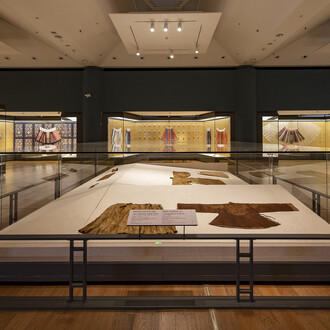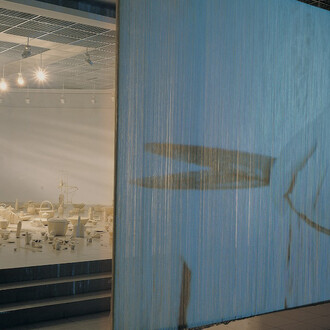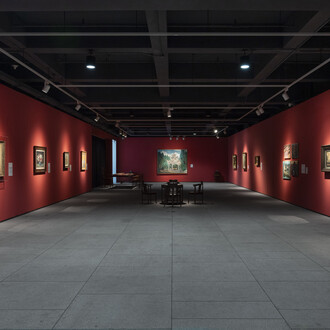For many years, Yang Shu has been accustomed to naming his paintings Untitled or alluding to Untitled and the pinyin abbreviation of his surname. Combined with his repeated public statements about “de-conceptualization” and “de-thematization”1 in painting, this move can be understood as his artistic (stance), a seemingly mild rejection of image style and narrative. This approach is not uncommon among contemporary artists. Refusing naming can be seen as refusing to be defined (or to be incorporated), and is a kind of projection (actively emphasized) of the negative aesthetics of contemporary art. Of course, it can also be understood as a form of self-coding, which tends to emphasize an endogenous image logic and actively suspend history2.(Compared to the “cheapness” of negative aesthetics, exploring the latter will be more constructive.)
No matter how you look at it (perhaps as the artist grows older), Yang Shu's painting style is becoming more and more distinct, consistently stunning with its rhythmic and free-flowing colors (widely regarded as the hallmark of his visual style). A deconstructed (non-central perspective) scattered painting style, local accumulation (rearrangement) of various everyday materials, graffiti-like colored lines (spray paint) guide (organize) the visual rhythm, either randomly intruding or jumping in (interfering), with light and dazzling color blocks. This is a type of pattern filled with contradictory tension, where lightness and distortion coexist, and a sense of fashion and “ruined” texture intertwine and coexist3.
Thus, a clear fracture is laid out before us, with one end being resistance to being defined (disciplined) and the other end being the active interpretation(construction) of self-stylization. The former points to the negation of Kantian modernism's autonomy4, while the latter is more closely related to the artist's choice of medium (experimentation) and the construction of visual style. Inhis famous thesis on artistic style, Wölfflin proposed a theory of double root of style, contextualizing the causes of artistic style within history (temperament, school, nation, race). He firmly believed that the formation of visual style cannot be separated from external factors such as the country and culture in which an individual lives, but that the more crucial driving force lies in the autonomous transformation of the “innerer Grund” (inner ground) of “ways of seeing” and the intertwining and mutual construction of the two sources5.
Yang Shu's paintings present us with the following proposition: how to reposition and re-examine art—particularly the localization practices (construction) of contemporary Chinese abstract art—in the context of the current fragmented(misaligned) historical-contextual framework. Although Wölfflin's cultural totalization and universalization attitudes have long been criticized (Benjamin believed that the answer to the problem of “romantic historiography” lay inmorein-depth thematic historical research, focusing on the gaps, fissures, andcontradictions in the assumed continuity of general history, as well as a moresubstantial “respect for the insignificant”), his conclusions regarding the mutual construction of visual “ways of seeing” and artistic styles still provide us withagreat deal of reliable evidence. Certainly, the prerequisite is that we fully recognize this historical discontinuity (Noi Sawaragi's concept of “bad place”6 in East Asian art history can give us some inspiration). The gaps, cracks, and contradictions in between can be the path for us to further analyze and explore.
(August 25th, 2025, Chongqing)
Notes
1 Qiu Min, 杨 述 : 无 趣 的 东 西 往 往 是 用 来 说 教 的 , in Art Suodeng, July 2023.
2 In 1951, art historian Alfred H. Barr pioneered the application of modern archival methods to the study of a single artist in his work Matisse: His Art and His Public, establishing a paradigm for “micro-archival studies” in art historical research. Yang Shu's longstanding self-coded initiatives and his
artistic practice of “de-conceptualizing” and “de-thematizing” painting both exhibit a pronounced self-contextualizing quality. “Micro-archival studies” would serve as an excellent approach for further
reading into the artist's work.
3 For related descriptions, see my article: Ni Kun, 粗鲁派,杨述的文化命题, 2023.
4 Kantian negation of heteronomy establishes the autonomy of art by negating its heteronomy—that is,
its subordination to external purposes such as morality or utility. It is not a rejection of content, but rather the
elimination of “non-artistic” elements, thereby preserving the pure formal domain for art.
5 Wölfflin proposed the renowned “double root of style” in his work Principles of Art History, positing
that the evolution of artistic styles stems from the dynamic interplay between two foundational forces: the
“endogenous root” (the visual logic inherent within the form itself) and the “exogenous root” (external
conditions such as society and technology).
6 “Bad Place” is a conceptual framework proposed by Japanese critic Noi Sawaragi to describe Japan's unique “non-historical structure”—a closed loop where historical trauma is repeatedly exploited yet never properly addressed. Compared to Europe, where art can be examined within its historical context, Japan's
reception of European modern art—particularly in terms of linguistic awareness, imagery expression, andtechnical development—has led to confusion when adapting these imported elements within Japan's
contemporary artistic framework.











